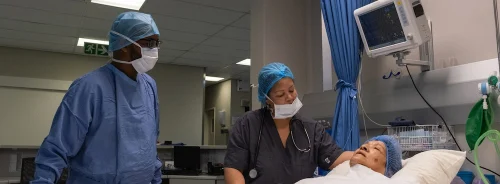ICU Management & Practice, ICU Volume 9 - Issue 4 - Winter 2009/2010
Authors

Sonia O. Labeau, MNSc
Faculty of Healthcare
University College Ghent, Faculty of Medicine and Health Sciences
Ghent University
Stijn I. Blot, PhD
Faculty of Healthcare, University College Ghent
Faculty of Medicine and Health Sciences and General Internal Medicine and Infectious Diseases
Ghent University

Jordi Rello, PhD
Intensive Care Unit
Joan XXIII Hospital, Tarragona, Spain;
University Rovira i Virgili – IISPV Tarragona, Spain.
Dominique M. Vandijck, PhD
Faculty of Medicine and Health Sciences and General Internal Medicine and Infectious Diseases
Ghent University, Ghent, Belgium
Infection prevention and control is of utmost importance. Nurses play a major role in the successful implementation of infection prevention strategies in the intensive care unit.
Healthcare-Associated Infections (HAIs) constitute a major health problem in the intensive care unit (ICU). They concern 5% to 10% of hospitalised patients in European and American acute care hospitals (Vrijens et al. 2008; Yokoe et al. 2008), and can lead to additional complications in up to 33% of those admitted to the ICU (Eggimann and Pittet 2001). Recently, the significant physical, social, psychological and economic burdens they cause have increased both government and public awareness of the importance of their prevention (Vandijck et al. 2007a, Vandijck et al. 2007b). This increasing alertness is reflected by the current trend towards holding each hospital employee accountable for his or her personal responsibilities regarding infection control, and by the tendency to consider HAIs avoidable medical errors (Jarvis 2007, Yokoe and Classen 2008). Also, in the United States, performance measures of HAI prevention have been integrated into regulatory and reimbursement systems, thereby illustrating the growing consensus that many HAIs are preventable, and that their prevention is a new healthcare imperative (Harbarth et al. 2003; Yokoe and Classen 2008).
Many principles of infection control are based on simple concepts, and the application of preventive strategies often consists of basic measures that are easy to implement (Eggimann and Pittet 2001; Vandijck et al. 2009). As managers of the daily care processes, nurses undeniably are key to the implementation of these measures at bedside, and play an important part in determining the success or failure of initiatives aimed at the prevention and control of infection in the ICU.
In mechanically ventilated patients, maintaining the pressure of high volume low pressure endotracheal tube cuffs above the critical value of 20 cmH2O is such a simple, but crucial nursing concern to prevent silent aspiration of oropharyngeal contents, and thereby ventilator-associated pneumonia (VAP) (Rello et al. 1996; Rello et al. 1999). Accurate monitoring by means of a well-calibrated manometer – continuously or regularly, and upon indication – is of pivotal importance for safeguarding cuff pressure within the 20 cmH2O - 30 cmH2O range. Regretfully, however, substantial practice variation and improper cuff management among ICU nurses have been reported (Labeau et al. 2009; Rose and Redl 2008).
Another marked example of a simple preventive strategy that is pre-eminently managed by the ICU nurse is elevation of the head of the patient’s bed to prevent VAP. In mechanically ventilated patients, semirecumbent position is associated with lower levels of aspiration of upper airway secretions into the lower airways (Ibáñez et al. 1992; Orozco-Levi et al. 1995; Torres et al. 1992) and a lower VAP incidence than the supine position (Drakulovic et al. 1999; Fernández-Crehuet et al. 1997; Kollef 1993). Particularly in patients receiving enteral nutrition, elevation of the head of the bed to 30° - 45° is effective in reducing the risk of VAP (Drakulovic et al. 1999). The feasibility of this strategy in daily practice was investigated by van Nieuwenhoven et al. who randomised 221 patients to a backrest of 45° or to a backrest of 10° (van Nieuwenhoven et al. 2006). Remarkably, in the 45° group the targeted position was not achieved, the average positional angle being 28°. No clear explanation forthis finding could be given. It was suggested that clinicianrelatedfactors such as motivation and commitment to adheringto scientific protocols might have been involved.
It is well known indeed that clinician’s adherence to protocols and guidelines is often limited (Castella et al. 2006; Grover et al. 2007; Rello et al. 2007; Rello et al. 2002; Ricart et al. 2003; Rickard et al. 2004; Rubinson et al. 2005; Sinuff et al. 2007; Vandijck et al. 2007). Among nurses, examples of non-compliance with evidence-based recommendations for infection prevention and infection control abound, as do self-reported barriers to adherence (Rello et al. 2007; Ricart et al. 2003; Rickard et al. 2004). Optimisation of guideline uptake and compliance is a complex process that requires insight in theories of behaviour change, and in the local potential facilitators and barriers related to adherence. Recently, a European study investigating ICU nurses’ knowledge of evidence-based guidelines for preventing VAP, central venous catheter-related infection and surgical site infection found the overall mean scores to be as low as 45.1%, 44.4% and 29.0% respectively, suggesting poor guideline knowledge to be a potential barrier to guideline adherence (Blot et al. 2007; Labeau et al. 2008; Labeau et al. 2009a; Labeau et al. 2009b). Although guideline knowledge does not guarantee adherence, logically, one cannot adhere to guidelines of which he/she does not know the contents. As such, interactive educational initiatives may be considered as first and crucial elements of multifaceted programmes that target the implementation of interventions for infection prevention and infection control in the ICU.
Implementation of change is known to be challenging. Especially when a permanent change in nurses’ well-established routine care is intended, sustained efforts and a multidisciplinary collaboration are basic prerequisites to success.
Until today, it is not fully understood which implementation strategies are more likely to be successful, but there is a general consensus that multifaceted programmes targeting different barriers to change are more effective than single interventions (Grimshaw et al. 2001). Still, little information is available to guide the choice, or optimise the components of such complex programmes in practice (Prior et al. 2008).
Berenholtz et al. have clearly demonstrated that the use of a well-defined set of multimodal, bundled implementation approaches, in which ICU nurses were cast in a major role succeeded in dramatically reducing central venous catheterrelated bloodstream infections (CVC-RBSI) (Berenholtz et al.
2004). In their study, a quality improvement team introduced the following five interventions in a surgical ICU over a fouryear period:
1) Education of the local staff;
2) Creation of a catheter insertion cart;
3) Daily assessment of the need for the catheter to remain in situ;
4) Implementation of a checklist to ensure adherence to evidence-based prevention guidelines; and
5) Empowerment of the nurses to stop catheter insertion if breaches in the procedure were detected.
Over the implementation period, a decrease in the rate of CVC-RBSI from 11.3 to zero per 1,000 catheter days was registered. The authors estimated that 43 cases of CVC-RBSI, eight deaths, and about 2 million USD in additional costs per year may have been prevented. As such, these hopeful study results have clearly exemplified that the implementation of preventive strategies can actually be effective over prolonged periods of time if they can be successfully integrated into the behaviour of all those who are involved in patient care (Berenholtz et al. 2004; Eggimann and Pittet 2001).
Finally, infection prevention and control is a dynamic process, requiring a continuous surveillance programme to monitor, guide and evaluate the implemented preventive strategies and to allow for benchmarking and quality improvement. The clinical expertise and accurate input from dedicated nurses who are committed to meticulously observing and reporting infection are essential to reduce the risk of HAI in the ICU.
In conclusion, despite the increase in awareness, there is still some considerable way to go to reduce HAI in the ICU. As nurses play a major role in warranting patient safety, taking up a leading part in the implementation of infection prevention programmes is an outstanding opportunity to promote themselves
as dedicated and responsible professionals, and key players within the multidisciplinary team.
References:
Berenholtz, S. M., Pronovost, P. J., Lipsett, P. A., Hobson, D., Earsing, K., Farley, J. E., Milanovich, S., Garrett-Mayer, E., Winters, B. D., Rubin, H. R., Dorman, T. & Perl, T. M. (2004) "Eliminating catheter-related bloodstream infections in the intensive care unit". Critical Care Medicine, 32, 2014-20.
Blot, S. I., Labeau, S., Vandijck, D. M., Van Aken, P. & Claes, B. (2007) "Evidence-based guidelines for the prevention of ventilator-associated pneumonia. Results of a knowledge test among intensive care nurses". Intensive Care Medicine, 33, 1463-67.
Drakulovic, M. B., Torres, A., Bauer, T. T., Nicolas, J. M., Nogue, S. & Ferrer, N. (1999) "Supine body position as a risk factor for nosocomial pneumonia in mechanically ventilated patients: a randomised trial". Lancet, 354 1851-1858.
Eggimann, P. & Pittet, D. (2001) "Infection control in the ICU". Chest, 120, 2059-93.
Grimshaw, J. M., Shirran, L., Thomas, R., Mowatt, G., Fraser, C., Bero, L., Grilli, R., Harvey, E., Oxman, A. & O'brien, M. A. (2001) "Changing provider behavior: An overview of systematic reviews of interventions". Medical Care, 39, II2-II45.
Labeau, S., Bleiman, M., Rello, J., Vandijck, D., Claes, B., Blot, S. & The Evidence Study Investigators (2009) "Intensive care nurses' knowledge and management of tracheal tube cuffs". Intensive Care Medicine, 35, S203.
Labeau, S., Vandijck, D., Rello, J., Adam, S., Rosa, A., Wenisch, C., Bäckman, C., Agbaht, K., Csomos, A., Seha, M., Dimopoulos, G., Vandewoude, K. H. & Blot, S. (2008) "Evidence-based guidelines for the prevention of ventilator-associated pneumonia: results of a knowledge test among European intensive care nurses". Journal of Hospital Infection, 70, 180- 185.
Labeau, S. O., Vandijck, D. M., Rello, J., Adam, S., Rosa, A., Wenisch, C., Backman, C., Agbaht, K., Csomos, A., Seha, M., Dimopoulos, G., Vandewoude, K. H., Blot, S. I. & For the Evidence Study Investigators (2009a) "Centers for disease control and prevention guidelines for preventing central venous catheter-related infection: Results of a knowledge test among 3405 European intensive care nurses". Critical Care Medicine, 37, 320-3.
Labeau, S., Witdouck, S., Vandijck, D., Claes, B., Rello, J., Vandewoude, K., Lizy, C., Vogelaers, D., Blot, S. & And on Behalf of the Executive Board of the Flemish Society for Critical Care Nurses (2009b) "Nurses’ knowledge of evidence-based guidelines for the prevention of surgical site infection." Worldviews on Evidence-Based Nursing, published online 16 November 2009, DOI 10.1111/j.1741-6787.2009.00177.x
Orozco-Levi, M., Torres, A., Ferrer, M., Piera, C., El-Ebiary, M., De La Bellacasa, J. P. & Rodriguez-Roisin, R. (1995) "Semirecumbent position protects from pulmonary aspiration but not completely from gastroesophageal reflux in mechanically ventilated patients". American Journal of Respiratory and Critical Care Medicine, 152, 1387-90.
Rello, J., Koulenti, D., Blot, S., Sierra, R., Diaz, E., Dewaele, J. J., Macor, A., Agbaht, K. & Rodriguez, A. (2007) "Oral care practices in intensive care units: a survey of 59 European ICUs". Intensive Care Medicine, 33, 1066-70.
Rello, J., Lorente, C., Bodì, M., Diaz, E., Ricart, M. & Kollef, M. H. (2002) "Why do physicians not follow evidence-based guidelines for preventing ventilator-associated pneumonia? A survey based on the opinions of an international panel of intensivists". Chest, 122, 656-661.
Rello, J., Sonora, R., Jubert, P., Artigas, A., Rue, M. & Valles, J. (1996) “Pneumonia in intubated patients: Role of respiratory airway care”. American Journal of Respiratory and Critical Care Medicine, 154, 111-115.
Ricart, M., Lorente, C., Diaz, E., Kollef, M. H. & Rello, J. (2003) "Nursing adherence with evidence-based guidelines for preventing ventilator-associated pneumonia". Critical Care Medicine, 31, 2693-2696.
Van Nieuwenhoven, C. A., Vandenbroucke-Grauls, C., Van Tiel, F. H., Joore, H. C. A., Van Schijndel, R. J. M. S., Van Der Tweel, I., Ramsay, G. & Bonten, M. J. M. (2006) "Feasibility and effects of the semirecumbent position to prevent ventilator-associated pneumonia: A randomised study". Critical Care Medicine, 34, 396-402.
Vandijck DM, Annemans L, Oeyen S, Blot SI & Decruyenaere JM (2007a). “Costeffectiveness in critical care”. ICU Management, 7, 6-8.
Vandijck DM, Decruyenaere JM, Labeau SO, Depaemelaere M & Blot SI (2007b). “Economic impact of catheter-related sepsis in the intensive care unit”. ICU Management, 7, 10.
Vandijck, D., Labeau, S., De Somere, J., Claes, B. & Blot, S. (2007) "Undergraduate nursing students' knowledge and perception of infection prevention and control". Journal of Hospital Infection, 68, 92-94
Vandijck, D. M., Labeau, S. O., Secanell, M., Rello, J. & Blot, S. I. (2009) "The role of nurses working in emergency and critical care environments in the prevention of intravascular catheter-related bloodstream infections". International Emergency Nursing, 17, 60-68.
Yokoe, D. S. & Classen, D. (2008) "Introduction: Improving patient safety through infection control: A new healthcare imperative". Infection Control and Hospital Epidemiology, 29, S3-S11.






